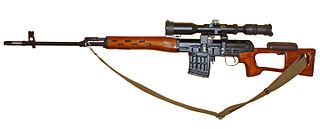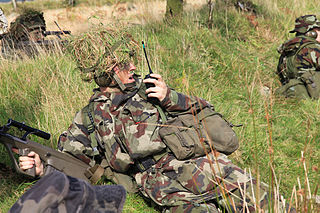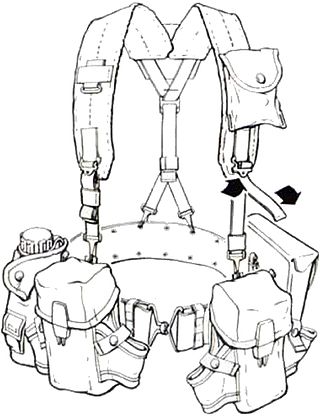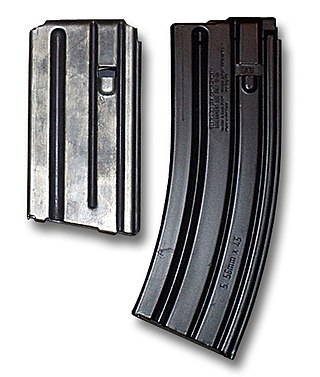
The Krag–Jørgensen is a repeating bolt-action rifle designed by the Norwegians Ole Herman Johannes Krag and Erik Jørgensen in the late 19th century. It was adopted as a standard arm by Norway, Denmark, and the United States. About 300 were delivered to Boer forces of the South African Republic.

The M16 rifle is a family of assault rifles adapted from the ArmaLite AR-15 rifle for the United States military. The original M16 rifle was a 5.56×45mm automatic rifle with a 20-round magazine.
The M14 rifle, officially the United States Rifle, Caliber 7.62 mm, M14, is an American battle rifle chambered for the 7.62×51mm NATO cartridge. It became the standard-issue rifle for the U.S. military in 1957, replacing the M1 Garand rifle in service with the U.S. Army by 1958 and the U.S. Marine Corps by 1965; deliveries of service rifles to the U.S. Army began in 1959. The M14 was used by the U.S. Army, Navy, and Marine Corps for Basic and Advanced Individual Training from the mid-1960s to the early 1970s.

The SVD, GRAU index 6V1, is a semi-automatic designated marksman rifle/sniper rifle chambered in the 7.62×54mmR cartridge, developed in the Soviet Union.
The Colt Canada C7 and C8 are a Canadian family of service rifles, manufactured by Colt Canada, having similar design and function to the Colt M16A3.

The vz. 58 is a 7.62×39mm assault rifle that was designed and manufactured in Czechoslovakia and accepted into service in the late 1950s as the 7,62 mm samopal vzor 58, replacing the vz. 52 self-loading rifle and the 7.62×25mm Tokarev Sa 24 and Sa 26 submachine guns.

The Close Quarter Battle Receiver (CQBR) is a replacement upper receiver for the M4A1 carbine developed by the US Navy.

A designated marksman rifle (DMR) is a modern scoped high-precision rifle used by infantry in the designated marksman (DM) role. It generally fills the engagement range gap between a service rifle and a dedicated sniper rifle, at around 300–600 metres (330–660 yd).

Personal load carrying equipment (PLCE) is one of several tactical webbing systems of the British Armed Forces. Dependent upon the year of design, and the decade of introduction, the webbing system was named and is commonly referred to as the 85 Pattern, the 90 Pattern or the 95 Pattern webbing.

The all-purpose lightweight individual carrying equipment (ALICE) is a set of load-carrying equipment adopted as United States Army Standard A on 17 January 1973 to replace the M-1956 individual load-carrying equipment (ILCE) and M-1967 modernized load-carrying equipment (MLCE). Although since superseded by MOLLE, ALICE gear is still in some limited use with the U.S. Army National Guard, State Guard, also some ground units of the Navy and Air Force.

The Heckler & Koch HK33 is a 5.56mm assault rifle developed in the 1960s by West German armament manufacturer Heckler & Koch GmbH (H&K), primarily for export.

The origins of the modern British military rifle are within its predecessor the Brown Bess musket. While a musket was largely inaccurate over 100 yards (91 m), due to a lack of rifling and a generous tolerance to allow for muzzle-loading, it was cheap to produce and could be loaded quickly. The use of volley or mass firing by troops meant that the rate of fire took precedence over accuracy.
The SG 550 is an assault rifle manufactured by SIG Sauer AG in Switzerland. "SG" is an abbreviation for Sturmgewehr. The rifle is based on the earlier 5.56×45mm NATO SIG SG 540.

The Beretta AR70/90 is a gas operated assault rifle chambered for the 5.56×45 mm NATO cartridge, and is the standard issue service rifle of the Italian Armed Forces. The weapon is also designed to be fitted with a rifle grenade, and has grenade sights. The AR series comes in many variants such as the AR90, with a wire folding stock, for use by paratroopers.

A STANAG magazine or NATO magazine is a type of detachable firearm magazine proposed by NATO in October 1980. Shortly after NATO's acceptance of the 5.56×45mm NATO rifle cartridge, Draft Standardization Agreement (STANAG) 4179 was proposed in order to allow NATO members to easily share rifle ammunition and magazines down to the individual soldier level. The U.S. M16 rifle's magazine proportions were proposed for standardization. Many NATO members, but not all, subsequently developed or purchased rifles with the ability to accept this type of magazine. However, the standard was never ratified and remains a "Draft STANAG".
The SG 540 is a 5.56×45mm NATO assault rifle developed in the early 1970s by Schweizerische Industrie Gesellschaft of Neuhausen, Switzerland as a private venture primarily destined for export markets and as a potential replacement for the 7.5×55mm Swiss SG 510 automatic rifle known as the Stgw 57 in Swiss service.

The Beretta ARX160 is an Italian modular assault rifle manufactured by Beretta. Developed for the Italian Armed Forces as part of the Soldato Futuro program, the ARX160 was launched in 2008 as a commercial weapon system independent from the Soldato Futuro ensemble, complete with a companion single-shot 40×46mm NATO low-velocity grenade launcher, called the GLX160, which can be mounted underneath the rifle or used with an ad hoc stock system as a stand-alone weapon.

Lewis Machine & Tool Company (LMT) is an American armaments company founded by Karl Lewis, in 1980. It manufactures weapon systems, including a variant of the M4 carbine and the M203 grenade launcher. Its products are used by the military forces of the United Kingdom, New Zealand, Estonia and the United States. It formerly produced forged FN FAL receivers for Illinois-based DS Arms.

The L1A1 Self-Loading Rifle (SLR), also known by the initial Canadian designation C1, or in the U.S. as the "inch pattern" FAL, is a British version of the Belgian FN FAL battle rifle. The L1A1 was produced under licence and adopted by the armed forces of the United Kingdom, Australia, Canada, India, Jamaica, Malaysia, New Zealand, Rhodesia and Singapore.
The CAN bayonet 2000/2005 is the up-to-date standard multi-purpose infantry bayonet of the Canadian Armed Forces, issued to match the C7/C8 service rifles as the successor of C7 Nella bayonet after 2004.
















